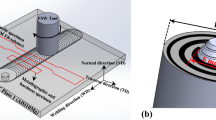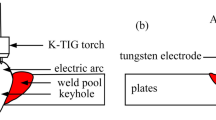Abstract
The present study describes how the effect of direction of welding is useful to minimize distortion in submerged arc welded double-sided fillet joints. In present work, angular distortion of 12 mm thick double-sided fillet welds was measured for same direction and reverse direction welding. It has been observed that the maximum magnitude of the angular distortion for reverse direction fillet welding is lower. Thermal history in horizontal and vertical plate of fillet welds was also measured for both same direction and reverse direction welding. After welding, the fillet welds were sectioned, polished and etched to measure the effect of direction of welding on weld bead geometry. To predict the temperature distribution and thermal history, a finite element (FE) elasto-plastic thermo-mechanical model has been developed for submerged arc welded double-sided fillet welds by using moving distributed heat source. The three-dimensional FE thermal model was verified by comparing peak temperature obtained with experimental values. The model results matched fairly well with experimental results with a variation of 6 percent for sample 1 and 7.5 percent for sample 2 for the maximum values of distortion, and a variation of 2-8 percent for peak temperatures in horizontal plate and 9 percent in web plate.
Similar content being viewed by others
References
Biswas, P., Mahapatra, M. M., and Mandal, N. R. (2009). “Numerical and experimental study on prediction of thermal history and residual deformation of double-sided fillet welding.” Journal of Engineering Manufacture, 224, pp. 125–134.
Brown, S. B. and Song, H. (1992). “Implication of threedimensional numerical simulation of welding of large structures.” Welding Journal, pp. 55–62.
Deng, D., Ninshu, M., and Murkawa, H. (2011). “Finite element analysis of welding distortion in large thin-plate panel structure.” Transactions of the Japan Welding Society, 40, pp. 89–100.
Deng, D., Murakawa, H., and Liang, W. (2007a). “Numerical simulation of welding distortion in large structures.” Computer Methods in Applied Mechanics and Engineering, 196, pp. 4613–4627.
Deng, D., Liang, W., and Murakawa, H. (2007b). “Determination of welding deformation in fillet-welded joint by means of numerical simulation and comparison with experimental measurements.” Journal of Material Processing Technology, 183, pp. 219–225.
Friedman, E. (1975). “Thermo-mechanical analysis of the welding process using the finite element method.” Trans. ASME, pp. 206–213.
Hong, J. K., Tsai, C. L., and Dong, P. (1998). “Assessment of numerical procedures for residual stress analysis of multipass weld.” Welding Journal, 77, pp. 372–382.
Mahapatra, M. M., Datta, G. L., Pradhan, B., and Mandal, N. R. (2007). “Modelling the effects of constraints and single axis welding process parameters on angular distortions in one-sided fillet welds.” Journal of Engineering Manufacture, 221(B3), pp. 397–407.
Mondal, A. K., Biswas, P., Bag, S., and Mahapatra, M. M. (2014). “Prediction of weld induced angular distortion of Single sided and double-sided fillet joint by SAW Process.” Proc. 5 th Int. Conf. on ‘Design and Research’, IIT Guwahati, 34(1)-34(6).
Michaleris, P. and Debiccari, A. (1997). “Prediction of welding distortion.” Welding Journal, 76(4), pp. 172–180.
Murakawa, H., Serizawa, H., and Shibahara, M. (2005). “Prediction of welding hot cracking using temperature dependent interface element-modelling of interfaces.” In: Mathematical modelling of weld phenomena, 7, pp. 539–554.
Mandal, N. R. and Adak, M. (2001). “Fusion zone and HAZ prediction through 3-D simulation of welding thermal cycle.” Journal of Mechanical Behaviour of Materials, 12(6), pp. 410–414.
Okada, A. (1977). “Application of melting efficiency and its problem.” Journal of Japan Welding Society, 46, pp. 53–61.
Pathak, A. K. and Datta, G. L. (2004). “Three-dimensional finite element analysis to predict the different zones of microstructure in submerged arc welding.” Journal of engineering manufacture, 218(B3), pp. 269–280.
Pathak, A. K. (2002). Three-dimensional finite element analysis of heat transfer in arc welding. Ph.D. Thesis, IIT kharagpur, India.
Rosenthal, D. (1941). “Mathematical theory of heat distribution during welding and cutting.” Welding Journal, 21(5), pp. 220–234.
Rosenthal D. (1946). “The theory of moving sources of heat and its application to metal treatments.” Trans. AIME, 43(11), pp. 849–866.
Teng, T. L., Fung, C. P., Chang, P. H., and Yang, W. C. (2001). “Analysis of residual stresses and distortions in Tjoint fillet welds.” International Journal of Pressure Vessels and Piping, 78, pp. 523–558.
Tsai, C. L. and Jung, H. (2004). “Plasticity based distortion analysis for fillet welded thin-plate T-joints.” Welding Journal, 83(6), pp. 177–187.
Author information
Authors and Affiliations
Corresponding author
Rights and permissions
About this article
Cite this article
Pandey, C., Giri, A. & Mahapatra, M.M. On the prediction of effect of direction of welding on bead geometry and residual deformation of double-sided fillet welds. Int J Steel Struct 16, 333–345 (2016). https://doi.org/10.1007/s13296-016-6007-z
Received:
Accepted:
Published:
Issue Date:
DOI: https://doi.org/10.1007/s13296-016-6007-z




